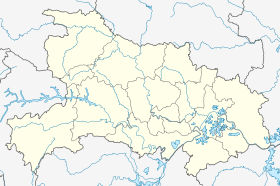Yingshan County, Hubei
| Yingshan County 英山县 | |
|---|---|
| County | |
 Yingshan Location in Hubei | |
| Coordinates: 30°59′N 115°48′E / 30.983°N 115.800°ECoordinates: 30°59′N 115°48′E / 30.983°N 115.800°E | |
| Country | People's Republic of China |
| Province | Hubei |
| Prefecture-level city | Huanggang |
| Area | |
| • Total | 1,449 km2 (559 sq mi) |
| Population (2004) | |
| • Total | 409,601 |
| • Density | 280/km2 (730/sq mi) |
| Time zone | China Standard (UTC+8) |
Yingshan County (simplified Chinese: 英山县; traditional Chinese: 英山縣; pinyin: Yīngshān Xiàn) is one of the seven counties governed by Huanggang City, Hubei, located on the eastern edge of the province, adjoining Anhui, and encompassing the southwestern portion of the Dabie Mountains. The county covers an area of 1,449 square kilometres (559 sq mi) and governs, as of 2004, 409,601 people in 11 townships.
Transport
History
Yingshan is famous as the birthplace of Bi Sheng, the inventor of movable-type printing technology in the 11th century, which is regarded as one of ancient China's "four great inventions". Communist guerrillas were active in the area in the early period of their insurgency, and the 27th Corps of the Red Army was set up there. It was also the point of departure for the 25th Corps on the Communists' Long March to Yan'an.
Economy
The county is rich in natural resources and produces tea, silk, herbs, chestnuts, and granite. Yingshan is the leading producer of Green Tea in Hubei and the fourth largest tea producer in China. There are four hot water springs in Yingshan town, with the water temperature recorded up to 71 Celsius degrees.